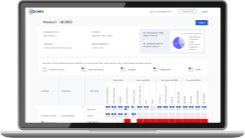
If your operations depend on the cloud, and chances are, they do, business continuity now hinges on something far more dynamic than a backup plan. In 2026, the cloud isn’t just hosting your applications. It’s where your customers interact, your teams collaborate, and your revenue flows.
But that advantage comes with exposure. CrowdStrike recently reported a 75% increase in cloud intrusions from 2022 to 2023. These aren’t theoretical risks. They’re attackers exploiting exactly what makes the cloud so powerful: its speed, flexibility, and scale. Misconfigurations, identity gaps, and unmonitored assets are giving them a way in.
For CIOs and infrastructure leaders, this means the safety net you had three years ago won’t hold today. For BCP managers and risk officers, it means continuity can no longer be treated as a post-incident checklist. As Gartner highlights, factors like geopolitical instability, fragmented supply chains, and the rise of generative AI are turning technical risks into business-critical ones.
The reality? Many continuity plans were built for a static world. The cloud isn’t static. It moves fast, scales wide, and introduces risk from places you can’t always see across vendors, regions, and services.
This blog explores how to rethink business continuity for that reality, what's changed, where the threats lie, and how forward-thinking teams are protecting resilience at the speed of cloud.
How the Cloud Transformed Business Continuity Planning
Business continuity planning used to be straightforward. You protected your infrastructure, planned for known threats, and rehearsed how to bring systems back online after a disruption. But with the cloud now powering critical operations, that approach no longer fits.
Why? Because cloud environments don’t behave like traditional IT. Systems are constantly changing. A single customer experience, say, placing an order online, might now rely on 10 or more interconnected cloud services running in different regions, with some owned by your vendors, rather than you.
This means the risks to continuity are no longer contained within your data center walls. If just one cloud service fails, an identity provider, a container registry, or a third-party API, the whole chain can break. These are realities that most continuity plans still don’t account for.
What’s more, recovery itself has changed. In the past, restoring operations meant recovering a server or database. Today, it might mean re-deploying a set of services, reconfiguring cloud permissions, or restoring workloads that auto-scale across regions. That requires coordination between infrastructure, DevOps, and security, not just IT support.
Continuity today is about architecture, not just documentation. You need systems that can withstand disruption by design, not just respond to it after the fact.
If your current continuity planning is still focused on backup locations and manual recovery, it’s time to rethink your approach.
Cloud Business Continuity Risks and Emerging Threats in 2026
A staggering 96% of organizations report growing concern about the scale and complexity of cloud security risks. As organizations scale cloud-native architectures, integrate third-party SaaS tools, and navigate rising geopolitical complexity, the threats to operational resilience have multiplied.
Based on insights from Gartner and CrowdStrike, the following are the most consequential threats that IT leaders, DevOps teams, and continuity managers must address now to safeguard long-term operations.

1. Compromised Cloud Identities and Service Accounts
Dormant service accounts and non-human identities, such as bots and automation scripts, are frequently overlooked in IAM audits. These blind spots are increasingly exploited by attackers to escalate privileges and maintain undetected access within cloud environments.
Continuity Risk: Privilege abuse, lateral compromise, and unplanned service downtime.
2. Credential and Secret Exposure in DevOps Pipelines
Hard-coded credentials and exposed secrets in source control, build pipelines, or environment variables continue to be a common attack vector. These vulnerabilities give adversaries the ability to impersonate trusted systems and move laterally across environments.
API security issues, often linked to exposed secrets or insecure service integrations, contribute to 7% of cloud security incidents.
Continuity Risk: DevOps trust breakdown, pipeline hijacks, and rapid compromise propagation.
3. Misconfigured SaaS Applications and Storage Buckets
Cloud storage platforms like S3 and SaaS tools such as Microsoft 365 or Google Workspace are often misconfigured. These errors, when undetected, expose sensitive data to the public or unauthorized users.
Data breaches remain the top-reported cloud incident, accounting for 21% of all cases, often caused by open storage or SaaS misconfigurations.
Continuity Risk: Breach disclosure obligations, regulatory penalties, and erosion of data trust.
4. Shadow Admin Access from Misconfigured RBAC
Improperly configured roles and unmonitored privilege inheritance within IAM systems create hidden administrative access. These shadow admin pathways are difficult to detect and are frequently exploited by attackers to take over systems without triggering alerts.
12% of cloud security incidents stem from configuration and access control failures, including overly broad roles and inherited admin privileges.
Continuity Risk: Governance breakdown, unauthorized systemic changes, and delayed response.
5. Cloud Supply Chain and CI/CD Pipeline Attacks
Adversaries increasingly target software build systems, injecting malicious dependencies into open-source libraries or tampering with CI/CD pipelines. These attacks compromise the integrity of releases and spread malware throughout production environments.
6. Extended Dwell & Detection Gaps
Edgescan found that 35.5 % of vulnerabilities in infrastructure/cloud layers are high‑severity. CrowdStrike reports that 79 % of detections are now malware‑free, relying on hands‑on‑keyboard tactics, and adversaries often dwell for weeks.
Continuity risk: deep compromise, high recovery costs, delayed remediation.
7. Hijacked SaaS Integrations and OAuth Token Abuse
SaaS platforms connected through OAuth tokens (such as Salesforce or Slack) are often insufficiently protected. Attackers use phishing and token theft to gain persistent access across multiple systems without triggering endpoint defenses.
Phishing and social engineering account for 10% of cloud incidents.
Continuity Risk: Lateral access escalation, unauthorized data exposure, and session hijacks.
8. Cloud Provider Lock-In and Regional Failover Gaps
Relying exclusively on a single cloud vendor without contingency or multi-region failover strategies introduces major continuity risks. Geopolitical disruptions, legal restrictions, or provider outages can result in prolonged operational impacts.
9% of cloud incidents directly lead to service disruption, often intensified by inadequate regional failover planning or overreliance on a single provider.
Continuity Risk: Cross-border business disruption, legal exposure, and inability to recover.
The Pillars of Cloud-Based Business Continuity Planning (BCP)
Cloud environments demand an integrated approach that anticipates threats, enables rapid response, and maintains trust across every layer of the digital enterprise.
Below are five foundational pillars that a modern cloud-based BCP must be built on:
.webp)
1. Visibility Across the Full Cloud Stack: From Code to Runtime
Business continuity begins with visibility. In highly dynamic cloud environments, where resources and threats shift by the minute, it’s impossible to defend what you can’t see. Ephemeral workloads, shadow environments, and misconfigurations often exist below the radar, increasing the risk of undetected drift and delayed response.
Achieving real-time, correlated insight across infrastructure, identity, workloads, APIs, and data flows enables teams to surface vulnerabilities early and act fast. It also allows continuity teams to monitor service health, identify potential degradation, and prevent incidents before they escalate. This isn’t just security hygiene; it’s operational foresight.
2. Security-First Architecture with Zero Trust and Cybersecurity Mesh
The resilience of cloud operations is directly shaped by how adaptable and integrated the underlying security architecture is. Traditional, siloed tools fall short when services span hybrid and multicloud deployments. Fragmented policies slow incident response and leave blind spots during disruptions.
Enter Cybersecurity Mesh Architecture (CSMA) and Zero Trust Network Access (ZTNA) frameworks that enable decentralized enforcement with centralized intelligence.
By embedding controls closer to assets while maintaining unified orchestration, they help maintain continuity even as infrastructure scales or pivots. When consolidated into composable Security Service Edge (SSE) platforms, supported by AI-driven analytics and open standards like OCSF, these architectures offer a robust foundation for uninterrupted service delivery even under pressure.
3. Identity-Centric Risk Management and Runtime Enforcement
Identity has become the control plane most vulnerable to compromise. In many cloud breaches, attackers don’t need to break in; they simply log in, leveraging over-permissioned roles, stale service accounts, or compromised credentials. These intrusions are difficult to detect, but their potential for disruption is high.
For continuity planning, this means treating identity as a live risk surface. Strong IAM practices least privilege by default, continuous entitlement analysis, and real-time behavioral enforcement help prevent unauthorized persistence and lateral movement that could bring down critical services. Continuity depends not just on access control but on making sure every identity behaves as expected throughout the entire cloud lifecycle.
4. Cloud-Native Misconfiguration Management with DevSecOps Alignment
Misconfigurations remain the leading cause of cloud-related incidents, often introduced when security and development operate in silos. A missed permission, an exposed API, or a rushed rollout can quietly erode the integrity of your cloud infrastructure until continuity is broken by downtime, data leakage, or compliance failure.
Business continuity strategies must embed governance directly into the development process. Real-time, context-aware monitoring of configurations, especially when integrated into CI/CD pipelines, helps teams catch and correct high-risk changes before they reach production. When DevSecOps alignment is tight, resilience becomes a byproduct of how teams build, not just how they react.
This high-impact incident underscores a critical lesson: even a single misconfiguration outside of application code can cascade into widespread disruption. It highlights the urgent need for governance embedded into DevSecOps workflows and real-time configuration monitoring to ensure business continuity in cloud-native environments.
5. Regulatory Resilience and Supply Chain Assurance
No continuity plan is complete without accounting for external dependencies and compliance variability. Whether it’s data residency mandates, SaaS vendor obligations, or geopolitical tensions, cloud ecosystems now carry a complex matrix of third-party and jurisdictional risk.
Even a localized cloud outage or non-compliant integration can ripple across operations. That’s why aligning BCP with governance, risk, and compliance (GRC) functions is essential. It enables organizations to proactively map legal exposures, monitor supplier reliability, and design failover strategies that account for cross-border constraints. In times of disruption, the ability to maintain compliance and continuity simultaneously becomes a true differentiator.
While each pillar tackles a different facet of cloud resilience, together, they form a tightly interwoven strategy for business continuity. Visibility supports early detection. The architecture enables scalable protection. Identity management reduces silent threats. DevSecOps bridges the gap between speed and safety. And regulatory assurance ensures operations don’t stall under external pressure.
In an era where continuity risks evolve as fast as the technology that enables them, cloud leaders must move from reactive protection to proactive preparedness built on these five pillars.
Business Continuity in Cloud: A Step-by-step Guide
Threats evolve faster, dependencies are more complex, and regulators expect tighter resilience. Here’s a step-by-step strategy to build a cloud-aligned BCP that is proactive, secure, and compliant.

1. Assess Cloud-Specific Risks and Business Impact
Traditional continuity plans miss cloud-native threats like privilege abuse, SaaS integration failure, and code-to-runtime drift. When organizations are experiencing misconfiguration incidents, risk mapping must start with cloud reality, not legacy assumptions.
Action:
- Conduct a cloud-specific Business Impact Analysis (BIA) that includes SaaS, IaaS, and PaaS services.
- Identify top risk scenarios: API abuse, credential leaks, IAM misconfigurations, etc.
- Use tools like Cloud Security Posture Management (CSPM) to flag misconfigured assets.
- Quantify operational, financial, and reputational impact of potential disruptions.
2. Map Critical Workloads, Data, and Dependencies
Without a clear map of cloud assets and their interdependencies, continuity plans fall apart under pressure. Cloud workloads are transient, and services often depend on hidden APIs, third-party libraries, and regional failover readiness.
Action:
- Create an up-to-date cloud asset inventory, including VMs, containers, SaaS apps, and microservices.
- Use automated dependency mapping tools to trace links between data, services, and user flows.
- Classify workloads by criticality (Tier 1/2/3) and assign RTO/RPO thresholds to each.
- Identify SaaS dependencies and third-party services your core systems rely on.
3. Align BCP Strategy with DevOps and Engineering Workflows
DevOps and site reliability engineers (SREs) are on the frontlines of cloud resilience but they’re rarely included in BCP planning. Embedding continuity into their workflows closes that gap.
Action:
- Define business continuity requirements (e.g., uptime SLAs, rollback windows) for product teams.
- Integrate BCP checkpoints into CI/CD pipelines using policy-as-code tools (e.g., Open Policy Agent).
- Create Git-based runbooks for common disruptions (e.g., database failover, permission revokes).
- Run joint tabletop exercises with engineering and security to test operational readiness.
4. Establish Runtime Threat Detection and Incident Playbooks
Most cloud attacks aren’t malware; they’re identity- and API-based, operating quietly across runtime environments. Traditional monitoring can’t detect or respond in time.
Action:
- Deploy cloud-native threat detection tools (e.g., CNAPP, SIEM, SOAR) integrated with IAM, API gateways, and runtime telemetry.
- Build incident playbooks for your top 5 disruption scenarios: data exfiltration, token hijack, supply chain tampering, etc.
- Assign clear roles, escalation chains, and remediation timelines within each playbook.
- Simulate real-world cloud attacks and conduct post-mortems to refine response maturity.
5. Integrate Compliance, Privacy, and Sovereignty Requirements
Cloud BCP must meet not just uptime goals but also legal obligations. A failover that violates GDPR or data sovereignty rules can cause more damage than the downtime itself.
Action:
- List applicable regulations (e.g., GDPR, HIPAA, DPDPA, CCPA) and their continuity implications.
- Audit cloud provider SLAs and shared responsibility models for compliance alignment.
- Use data classification and egress control tools to restrict regional data flow.
- Build geo-specific failover strategies that honor data residency and access control laws.
6. Simulate and Continuously Improve Cloud Resilience
Planning alone won’t prepare your organization for real-world chaos. Cloud BCP needs iterative testing, role-specific drills, and scenario-based improvement.
Action:
- Schedule quarterly cloud resilience drills (failover, identity compromise, regional outage).
- Use chaos engineering (e.g., AWS Fault Injection Simulator, Gremlin) to validate runtime fault tolerance.
- Score each simulation on recovery time, communication speed, data integrity, and SLA impact.
- Create a feedback loop that adjusts playbooks, tooling, and team readiness based on outcomes.
By integrating security, operations, compliance, and engineering into a unified continuity approach, your cloud BCP becomes more than a risk document; it becomes a resilience engine.
Case Study: The 2024 CrowdStrike Outage: When One Update Took Down the World
In July 2024, a faulty update from cybersecurity firm CrowdStrike caused one of the most catastrophic business continuity failures in cloud-era history. Though CrowdStrike’s Falcon sensor is designed to protect systems from malware and unauthorized access, a single misconfigured update pushed to millions of Windows devices globally resulted in massive outages across airlines, hospitals, retailers, and media networks.
What Went Wrong?
CrowdStrike’s Falcon agent operates in kernel mode, a privileged layer of Microsoft Windows systems. On July 19, 2024, the company released a configuration update targeting Channel File 291, used to monitor named pipes. The change led to an out-of-bounds memory read, triggering invalid page errors and crashing machines on reboot.
- Affected systems entered boot loops or failed to restart at all.
- The disruption began on Microsoft Azure virtual machines and then spread to Google Cloud, on-prem systems, and enterprise endpoints across the globe.
CrowdStrike CEO George Kurtz quickly confirmed the cause and issued a rollback. But by then, the damage was done. Over 8.5 million devices were affected, causing $10 billion+ in global financial damage.
Global Business Disruption Highlights
1. Airlines:
- Delta, United, and American Airlines canceled 10,000+ flights globally.
- Airports in Europe (Schiphol, Zurich) and Asia (Singapore) reported operational halts.
2. Rail and Public Transit:
- UK rail lines (e.g., Thameslink, Southern) saw delays due to failures in driver routing systems.
- Real-time information systems collapsed across stations.
3. Healthcare:
- In the U.S. and Europe, hospitals paused non-emergency care and lost access to EMRs and scheduling systems.
- Systems like the UK’s NHS EMIS Web went offline, impacting prescriptions and appointments.
- Pharmaceutical production in Slovenia halted entirely.
4. Retail and Logistics:
- 7-Eleven, Amazon, and major supermarkets operated on cash-only systems or shut down entirely.
- UPS, FedEx, and global logistics providers faced routing and tracking outages.
- The ‘Relay’ app for Amazon truck drivers went offline, halting shipments.
5. Media and Tech:
- BBC, Sky News, TF1, and ESPN faced broadcast failures.
- Vodafone, Google Cloud, and Instagram experienced partial or full outages.
- 2024 Summer Olympics logistics (e.g., uniform distribution) were disrupted in Paris.
Lessons in Business Continuity and Risk Management
1. Beware the Kernel Mode Trap
Software operating in privileged layers must undergo rigorous pre-deployment testing. A single faulty configuration at the kernel level can create global downtime. Alternatives like eBPF and memory-safe languages (e.g., Rust) are now being explored.
2. Decouple Critical Functions
The lack of system segmentation, especially in tightly coupled environments like airlines or healthcare, amplified the blast radius. Continuity planning must include isolation strategies and operational decoupling.
3. Demand Vendor Resilience and SLAs
Overreliance on third-party vendors, even for security, introduces systemic risk. Organizations must enforce clear rollback paths, staged rollouts, and business continuity clauses in contracts.
4. Transparent Incident Leadership
CrowdStrike’s quick communication and acknowledgment, led by CEO George Kurtz, was a rare example of responsible incident response. This transparency reduced panic and enabled global recovery.
5. Test Your Recovery, Don’t Assume It
Many organizations realized too late that they had no automated failover or recovery process. Business Continuity and Disaster Recovery (BCDR) strategies must go beyond paper plans and involve regular chaos engineering simulations and live drills.
Why This Case Matters
The CrowdStrike incident is a lesson in systemic fragility. In an interconnected world, even well-intended security tools can become points of failure. The outage served as a stress test for BCP maturity across industries and exposed weaknesses in vendor management, deployment governance, and failover design.
For BCP leaders, this was the wake-up call:
- Not all continuity threats are malicious.
- Not all resilience can be outsourced.
- Not all disasters start in your systems.
Final Takeaway
The 2024 CrowdStrike outage made it brutally clear: even the most secure environments can crumble from a single misstep. And when they do, it's not just systems that suffer; it's operations, trust, and brand equity.
The cloud's flexibility and speed are double-edged swords. To keep pace, you need strong systems; you also need skilled people behind them because no failover plan, zero-trust framework, or automation pipeline will hold if the teams running them aren't ready.
And that readiness begins with capability building.
At Edstellar, we help forward-thinking organizations transform their cloud resilience by empowering their people. Our corporate training programs and proprietary Skill Matrix software give you complete visibility into your team's cloud capabilities, identify continuity-critical skill gaps, and deliver personalized, outcome-aligned training plans.
Whether you need to harden IAM policies, reduce misconfigurations, or embed continuity into DevOps workflows, we help your workforce build the exact skills they need to prevent the next disruption, not just react to it.
Let's Make Continuity Your Competitive Advantage because resilience isn't a checklist; it's a capability. And in the cloud, it's a capability that starts with your people.
From C-suite to DevOps, from security architects to SREs, we design and deliver training programs that match your systems, your risks, and your pace of change.
Let's build a cloud continuity plan that stands strong together. In a world where resilience can't be left to chance, we're here to make sure it never has to be.
Explore High-impact instructor-led training for your teams.
#On-site #Virtual #GroupTraining #Customized

Bridge the Gap Between Learning & Performance
Turn Your Training Programs Into Revenue Drivers.
Schedule a ConsultationEdstellar Training Catalog
Explore 2000+ industry ready instructor-led training programs.

Coaching that Unlocks Potential
Create dynamic leaders and cohesive teams. Learn more now!


Want to evaluate your team’s skill gaps?
Do a quick Skill gap analysis with Edstellar’s Free Skill Matrix tool

Transform Your L&D Strategy Today
Unlock premium resources, tools, and frameworks designed for HR and learning professionals. Our L&D Hub gives you everything needed to elevate your organization's training approach.
Access L&D Hub Resources.svg)
.svg)



.svg)

.svg)
.svg)
.svg)
.svg)

